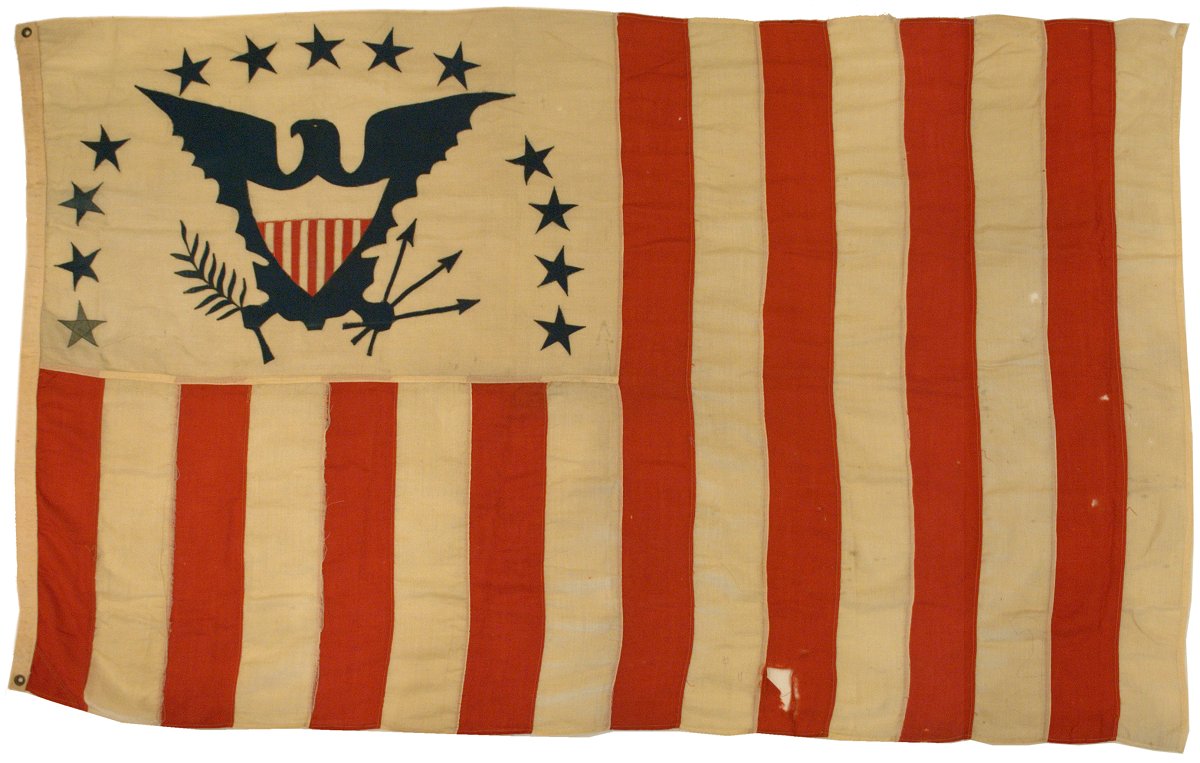
This flag is a very
rare pieced-and-sewn example of the American
Civil Flag, also known as the Revenue Cutter Flag. Revenue
Cutter flags of any era are very scarce. The
Treasury Department only operated a relatively small number of vessels in the American Revenue
Cutter fleet, and this style of American flag was only
used in the official capacity as the ensign of this
fleet. Of the very few examples of
these flags that have survived, each are distinct and
exciting to behold in part because they often have
uniquely shaped and very folky depictions of the
American Eagle from the Coat of Arms of the United
States. On this example, the wings of the eagle are
almost bat-like, and very stylized. The eagle and
stars are sewn using a zig-zag stitch which would
indicate construction circa 1895. The flag is in
excellent condition, and is one of the finest of the
very few examples of the type that I have seen. While
this flag may appear unusual to many Americans, it
design is, along with the traditional Stars and Stripes
pattern, an official design of the American flag.
Known as the Civil Flag of the United States, and also
as the Revenue Cutter flag, it is the precursor to
today's modern official Coast Guard flag. In 1790,
during George Washington's first presidential
administration, Secretary of the Treasury Alexander
Hamilton petitioned Congress to build and commission 10
vessels, known as Revenue Cutters, for the purposes of
reducing piracy and ensuring that shipping tariffs were
levied and collected from merchant ships arriving at
American ports. Congress approved the measure, and
on March 2, 1799, they passed the Customs Administration
Act, which established the law under which the Revenue
Cutters would operate. The Act also indicated that
the ships would signal to other vessels their role with
a unique flag, different than the Stars and Stripes seen
on ships of war. The Act required the design and
use of "an ensign and pendant, with such marks thereon
as shall be prescribed and directed by the President of
the United States." Oliver Walcott, who replaced
Alexander Hamilton as the Secretary of the Treasury in
1795, designed the ensign in 1799 and submitted it for
approval to President John Adams. His design
involved rotating the stripes to the vertical
orientation, and including 16 stripes since the nation
had 16 states by 1799. It also included the Coat
of Arms of the United States, consisting of the heraldic
eagle with shield and arch of 13 stars to represent the
original 13 colonies, in blue on a white canton.
The Revenue Cutters, which operated under the
jurisdiction of the Treasury Department rather than Navy
vessels which operated under the jurisdiction of the War
Department, continued to fly this style of flag until
the establishment of the Coast Guard, which subsumed the
Revenue Cutter and Lighthouse Services. The Coast
Guard modified the flag by placing its seal atop the
stripes to the right side of the flag, thus ending the
use of the Revenue Cutter flags of the design seen in
this example.
|

